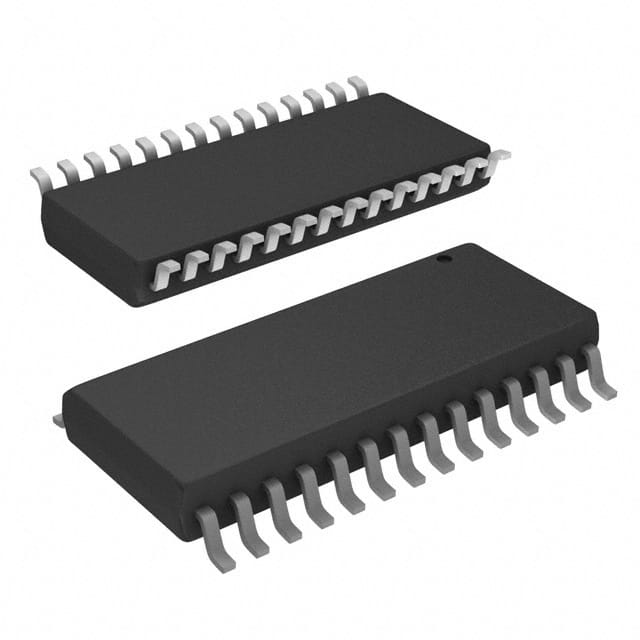Xem thông số kỹ thuật để biết chi tiết sản phẩm.

DSPIC33FJ16MC102-E/SO
Introduction
The DSPIC33FJ16MC102-E/SO is a digital signal controller (DSC) belonging to the family of 16-bit microcontrollers. This entry provides an overview of its category, use, characteristics, package, essence, packaging/quantity, specifications, detailed pin configuration, functional features, advantages and disadvantages, working principles, detailed application field plans, and alternative models.
Basic Information Overview
- Category: Digital Signal Controller (DSC)
- Use: The DSPIC33FJ16MC102-E/SO is designed for applications requiring high-performance digital signal processing and control functions.
- Characteristics: It features high computational performance, integrated peripherals, and flexible communication options.
- Package: SOIC (Small Outline Integrated Circuit)
- Essence: The essence of this product lies in its ability to efficiently process digital signals and perform complex control tasks.
- Packaging/Quantity: It is typically available in tape and reel packaging with varying quantities.
Specifications
The key specifications of the DSPIC33FJ16MC102-E/SO include: - High-Speed PWM modules - Analog-to-Digital Converter (ADC) with multiple channels - Enhanced Universal Asynchronous Receiver/Transmitter (UART) - Enhanced Capture/Compare/PWM (ECCP) modules - Operating Voltage: 3.0V to 3.6V - Operating Temperature Range: -40°C to 125°C - Flash Program Memory: 16 KB - RAM Data Memory: 1 KB - I/O Pins: 28
Detailed Pin Configuration
The detailed pin configuration of the DSPIC33FJ16MC102-E/SO can be found in the official datasheet provided by the manufacturer.
Functional Features
- High computational performance for digital signal processing
- Integrated peripherals for versatile application support
- Flexible communication options for seamless connectivity
- Enhanced control capabilities for precision applications
Advantages and Disadvantages
Advantages
- High-speed PWM modules enable precise control of power electronics.
- Integrated ADC facilitates analog signal acquisition and processing.
- Enhanced communication modules support seamless data exchange.
- Efficient control algorithms for motor control and power conversion applications.
Disadvantages
- Limited program memory and data memory compared to higher-end DSCs.
- Restricted I/O pin count may limit connectivity in complex systems.
Working Principles
The DSPIC33FJ16MC102-E/SO operates on the principle of executing high-speed digital signal processing algorithms and control routines. It leverages its integrated peripherals and communication modules to interface with external sensors, actuators, and communication networks, enabling efficient control and signal processing operations.
Detailed Application Field Plans
The DSPIC33FJ16MC102-E/SO is well-suited for various applications, including: - Motor Control: Its high-speed PWM modules and enhanced control capabilities make it ideal for motor control applications in industrial and automotive systems. - Power Electronics: The integrated ADC and communication modules enable precise control and monitoring of power electronic circuits. - Digital Power Supplies: Its computational performance and control features are beneficial for digital power supply applications.
Detailed and Complete Alternative Models
Some alternative models to the DSPIC33FJ16MC102-E/SO include: - DSPIC33FJ16MC101-E/SO: A similar DSC with reduced memory and peripheral features. - DSPIC33FJ32MC202-E/SO: A higher-end DSC with expanded memory and advanced peripherals.
In conclusion, the DSPIC33FJ16MC102-E/SO offers high-performance digital signal processing and control capabilities, making it suitable for a wide range of applications in the industrial, automotive, and power electronics domains.
Word Count: 515
Liệt kê 10 câu hỏi và câu trả lời thường gặp liên quan đến ứng dụng DSPIC33FJ16MC102-E/SO trong giải pháp kỹ thuật
Question: What are the key features of DSPIC33FJ16MC102-E/SO?
Answer: The DSPIC33FJ16MC102-E/SO features a 16-bit microcontroller core, high-performance DSC architecture, and various integrated peripherals for efficient signal processing.Question: How can I program DSPIC33FJ16MC102-E/SO?
Answer: You can program DSPIC33FJ16MC102-E/SO using MPLAB X IDE and a compatible programming tool such as PICkit or ICD.Question: What are the recommended operating conditions for DSPIC33FJ16MC102-E/SO?
Answer: The recommended operating voltage range is 2.5V to 5.5V, and the temperature range is -40°C to 125°C.Question: Can DSPIC33FJ16MC102-E/SO be used for motor control applications?
Answer: Yes, DSPIC33FJ16MC102-E/SO is suitable for motor control applications due to its advanced PWM modules and motor control peripherals.Question: Does DSPIC33FJ16MC102-E/SO support communication interfaces?
Answer: Yes, DSPIC33FJ16MC102-E/SO supports various communication interfaces including UART, SPI, and I2C for seamless connectivity.Question: What development tools are available for DSPIC33FJ16MC102-E/SO?
Answer: Development tools such as MPLAB Xpress Evaluation Board and Curiosity Development Board are available for DSPIC33FJ16MC102-E/SO.Question: Can DSPIC33FJ16MC102-E/SO be used in low-power applications?
Answer: Yes, DSPIC33FJ16MC102-E/SO offers low-power modes and features to support energy-efficient designs.Question: Is DSPIC33FJ16MC102-E/SO suitable for digital power supply applications?
Answer: Yes, DSPIC33FJ16MC102-E/SO is well-suited for digital power supply applications with its advanced analog-to-digital converters and control peripherals.Question: What are the memory options available in DSPIC33FJ16MC102-E/SO?
Answer: DSPIC33FJ16MC102-E/SO features Flash program memory, SRAM data memory, and EEPROM data memory for versatile storage options.Question: Can DSPIC33FJ16MC102-E/SO be used in automotive applications?
Answer: Yes, DSPIC33FJ16MC102-E/SO is AEC-Q100 Grade 1 qualified, making it suitable for automotive applications requiring high reliability and performance.

